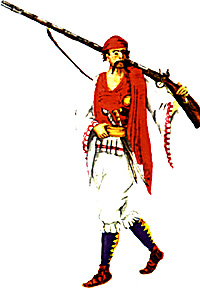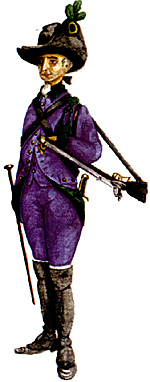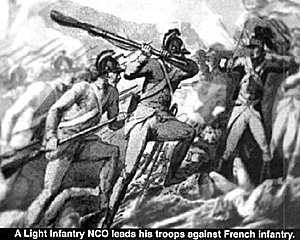 Based on a 1798 print, this Wurmser Freikorps infantryman wears the more unusual white uniform with red decoration and the typical Balkan small cap.
Based on a 1798 print, this Wurmser Freikorps infantryman wears the more unusual white uniform with red decoration and the typical Balkan small cap.
The Freikorps raised during the Turkish War and First Coalition displayed varying standards of discipline. The larger western Jager units survived as separate entities, being already effective and disciplined light units. These three units wore similar uniforms based on the Tyrolean style. As the province was not subject to conscription, the Tyrol had provided volunteer Jager units during the 18th century, but the latest unit, the Tyrolean Feld Jagerkorps was raised in 1788 from volunteers. Their uniform, the archetypal Jager uniform, widely imitated, comprised a German style line pattern jacket and trousers in pikegrey, then still a mid-blue rather than the later darkish blue of the 1808 regular Jager battalions. 1798 saw the introduction of a new simpler pattern tunic, but the non-Line troops would have taken longer to acquire it. The earlier Tyrolean uniform in the 1769 pattern is shown in the Osprey MAA with the figure in the official Kaskeft (leather hat) and likewise, from 1798, they were supposed to wear the new crested helmet, issued to the Line, albeit with a green/black crest instead of the usual yellowblack. However, the troops themselves preferred a simple Jagerhut, a felt hat turned up on one side, which later became the formalised Corsehut.
 D'Aspre German Jager still wearing the 1769 style uniform and a simple felt hat. On his shoulder, his green tassles denote a jagar, whereas the Schutzen (sharpshooters) wore black.
D'Aspre German Jager still wearing the 1769 style uniform and a simple felt hat. On his shoulder, his green tassles denote a jagar, whereas the Schutzen (sharpshooters) wore black.
In addition, a battalion of German Jager was formed as a separate unit in 1790 from detachments of volunteer sharpshooters attached to each non-Hungarian Line regiment in the Turkish War. They are usually known by their Inhaber titles: 1790: Dandini; 1792: Mahoney; 1799: D'Aspre. In 1790, they had been formed up into ten companies wearing the same uniform as the Tyroleans with the simple hat, except their facings were steel green rather than the Tyrolean dark green. In addition to rifles, carbines and probably muskets, some soldiers used the Doppelstutz, an overunder double-barrelled weapon more famously used by the sharpshooters in the Grenzer regiments. Similarly, the Le Loup Jager had been raised in the Austrian Netherlands with some German volunteers in the same uniform.
The units formed in the Netherlands and from French emigrees were not likely to receive additional troops from those sources and the authorities were reluctant to encourage further waves of Balkan population movements through the Frontier. So, together with the Galician troops, who were not considered that reliable, following the 1797 Peace of Campo Formic, the authorities decide to regularise these units into 15 Light Infantry Battalions. Although Lombardy had been lost under the Peace, Venice and most of its Adriatic enclaves were acquired, which would provide the necessary extra recruiting ground for these units.
Two Balkan units were kept out of the reorganisation: First, the Croat-Slavonian Sharpshooters had been formed in 1792, based on a previous Turkish Wars unit, from Croatian and Slavonian Grenzer under Oberst Franz von Jellacic from the Szluin Regiment. Joined by volunteers from Civilian Croatia and Slavonia in the following year, the Croat-Slavonian Sharpshooters were expanded to two battalions, wearing the distinct brown piped red uniform with a black Klobuk (Balkan cylindrical felt hat) shown in MAA299. The 1st was now based around Grenzer cadres from the Karlstadt and Banal Districts, the 2nd from Slavonia and Warasdin. The 2nd battalion was disbanded in December 1797, the 1st remaining. in service until disbandment in December 1799, their troops being drafted into the local Grenzer battalions.
The other, the Wurmser Freikorps, was originally intended to form the 8th Light Battalion, but was kept separate, mainly because of its indiscipline. Formed in 1793 mostly from Serb and Croat refugees displaced from Bosnia and Serbia by the fighting with Turkey, they were financed by contributions from the people of Graz, the main depot and fortress behind the western Frontier. However, having enlisted in the hope of getting land, they lacked discipline and remained a "constant source of difficulties".
After the definitive peace with Turkey of 1795, it was clear no land would be available and the Vienna Hofkriegsrat decreed that they would stay on field service. They wore their traditional Balkan clothing of a baggy, often open-necked shirt, with baggy trousers and a wide belt of leather of cloth holding assorted knives and pistols. Resembling the Seressaner scouts attached to the Karlstadt Grenzer battalions, which had come from the same area, the Wurmser usually wore a blue uniform, although it was sometimes white, as illustrated.
 Unlike the rest of the infantry, the new Light Battalions
units were known by their commanding Colonel (Oberst),
as they had no Inhabers.
Unlike the rest of the infantry, the new Light Battalions
units were known by their commanding Colonel (Oberst),
as they had no Inhabers.
Officially, the uniform was similar to the pike-grey Jager uniforms. However, the shortages of supplies and availability of alternatives appears to have meant that former Serb and Croat troops wore the Hungarian style infantry cornflower blue skin-tight trousers with yellow side stripes. Similarly, drawing on their local Line regiments, their jackets displayed the Hungarian pointed cuffs. Western and Galician battalions wore German trousers with no decoration and plain cuffs.
In addition, there are unofficial references to the 16th and 17th Light Infantry, although they were never part of the formal structure: The 16th was the Dalmatian Light Infantry battalion under Major Ertel, comprising Dalmatians, Italians, Turks and Montenegrins, wearing normal baggy Dalmatian dress similar to the Seressaner and Wurmser Freikorps.
The 17th under Major Buonacorsi, known as the Italian Light Infantry Battalion or Mariassy Jdger, had originally been part of the Piedmontese army. This uniform has been recreated by a Piedmontese re-enactment unit, illustrated in the article 'The Battle of Loano 1795' in AoN21.
All these battalions were to be issued with the new 1798 pattern 6 Zoll (nearly 7 in) high black-laquered helmet, although instead of the full brass plate to the front, theirs merely had the imperial cypher 'FII' (gilt for officers).
In late 1799, the fighting gradually petered out, as the Austrian troops went into winter quarters. Much of the fighting had taken place in the difficult terrain of northern Italy and southern Germany, so the commanders at Army HQ in Germany felt they were still short of light troops and attempted to raise volunteers in southern Germany for new light units. Typically, Archduke Charles' circular letter to the states of the Holy Roman Empire of 4th December requesting additional levies met with little response and the Austrians would remain at a disadvantage in the light role during 1800.
Defeat in the Second Coalition heralded huge cuts in the military budget and except for the Tyrolean Jager, all the light units were disbanded. The Tyroleans along with the German-speaking remnants of the Le Loup and d'Aspre now formed the new Line regiment, IR64 Tyrolean Feidjager Regiment. Surplus troops were drafted into IR46, the local Tyrolean Line regiment. Units from the Military Frontier and local Balkan lands were drafted into the Grenzer to form up the requisite two field battalions and depots, while the remaining Light Battalion troops were enlisted into the regular Line units, further ethnically confusing some of them, (see the nationality table above).
Sources
Wrede: Geschichte der kuk Wehrmacht (Supplement to the Mitteilungen des Kriegsarchivs series) (1898-1903)
Rothenburg: Napoleon's Great Adversaries (1982, rep. 1995)
Rothenburg: The Military Border in Croatia 1740-1881 (1966)
Tranquillo Mollo/Kininger: 1798 Uniform Plates
Austrian Militar Almanach for 1798, 1799 and 1800
Hollins: Osprey Men-At-Arms 299: Austrian Auxiliary Troops 1792-1816
PICTURE CREDITS
Light Infantry Illustrations by John Cook
Austrian Light Infantry 1799-1801 by Dave Hollins
-
Background
Grenz and Other Regiments
FreiKorps, Jagers, and Balkan Units
Illustrations (slow: 121K)
Chart of Battalions
Back to Age of Napoleon 26 Table of Contents
Back to Age of Napoleon List of Issues
Back to MagWeb Master List of Magazines
© Copyright 1998 by Partizan Press.
This article appears in MagWeb (Magazine Web) on the Internet World Wide Web.
Other military history articles and gaming articles are available at http://www.magweb.com